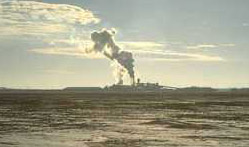Mar 12 2009
A University of Maryland-led team has compiled the first decades-long database of aerosol measurements over land, making possible new research into how air pollution affects climate change.
 Industrial pollution clouds an otherwise clear sky
Industrial pollution clouds an otherwise clear sky
Using this new database, the researchers show that clear sky visibility over land has decreased globally over the past 30 years, indicative of increases in aerosols, or airborne pollution. Their findings are published in the March 13 issue of Science.
“Creation of this database is a big step forward for researching long-term changes in air pollution and correlating these with climate change,” said Kaicun Wang, assistant research scientist in the University of Maryland’s department of geography and lead author of the paper. “And it is the first time we have gotten global long-term aerosol information over land to go with information already available on aerosol measurements over the world’s oceans.”
Wang, together with Shunlin Liang, a University of Maryland professor of geography, and Robert Dickinson, a professor of geological science at the University of Texas, Austin, created a database that includes visibility measurements taken from 1973 – 2007 at 3,250 meteorological stations all over the world and released by the National Climatic Data Center (NCDC). Visibility was the distance a meteorological observer could see clearly from the measurement source. The more aerosols present in the air, the shorter the visibility distance.
According to the researchers, the visibility data were compared to available satellite data (2000-2007), and found to be comparable as an indicator of aerosol concentration in the air. Thus, they conclude, the visibility data provide a valid source from which scientists can study correlations between air pollution and climate change.
Aerosols, Greenhouse Gases and Climate Change
Aerosols are solid particles or liquid droplets suspended in air. They include soot, dust and sulfur dioxide particles, and are what we commonly think of when we talk about air pollution. Aerosols come, for example, from the combustion of fossil fuels, industrial processes, and biomass burning of tropical rainforests. They can be hazardous to both human health and the environment.
Aerosol particles affect the Earth’s surface temperature by either reflecting light back into space, thus reducing solar radiation at Earth’s surface, or absorbing solar radiation, thus heating the atmosphere. The variable cooling and heating effects of aerosols also modify properties of cloud cover and rainfall.
Unlike aerosol particles, carbon dioxide and other greenhouse gases are transparent and have no effect on visibility. Sunlight passes right through them, just as it does through the oxygen and nitrogen that are the main constituents of our atmosphere. Though present in the atmosphere in relatively small amounts, greenhouse gases cause global warming because these “trace” gases trap solar energy absorbed at the earth's surface and prevent it from being radiated as heat back into space.
While the climate warming impacts of increased greenhouse gases are clear, the effects of increased aerosols are not. Studies of the long-term effects of aerosols on climate change have been largely inconclusive up to now due to limited over-land aerosol measurements, according to Wang and his team. However, with this database researchers now can compare temperature, rainfall and cloud cover data from the past 35 years with the aerosol measurements in the new database.
Global Dimming
According to the authors, a preliminary analysis of the database measurements shows a steady increase in aerosols over the period from 1973 to 2007. Increased aerosols in the atmosphere block solar radiation from the earth’s surface, and have thus caused a net “global dimming.” The only region that does not show an increase in aerosols is Europe, which has actually experienced a “global brightening,” the authors say.
The largest known source of increased aerosols is increased burning of fossil fuels. And a major product of fossil fuel combustion is sulfur dioxide. Thus, the team notes, that their finding of a steady increase in aerosols in recent decades, also suggests an increase in sulfate aerosols. This differs from studies recently cited by the Intergovernmental Panel Climate Change showing global emissions of sulfate aerosol decreased between 1980 and 2000.
Climate Change Research at Maryland
Visit the University of Maryland's Climate Change Microsite to find the latest climate news from around the world; information on the university's climate change research and partnerships with NOAA, NASA & DOE; and links to leading U.S. and international sources of climate information. http://www.newsdesk.umd.edu/micro/index.cfm